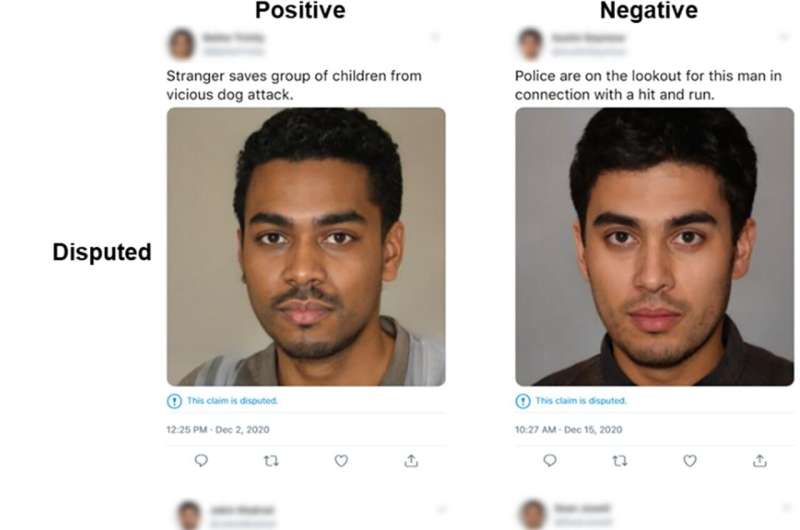Example tweet stimuli. Stimuli encountered by participants during the study phase. Face stimuli taken from Generate Photos (https://generated.photos/datasets) and tweets created in (www.tweetgen.com). Credit: Eggleston et al., 2022, PLOS ONE, CC-BY 4.0 (creativecommons.org/licenses/by/4.0/)
In experiments using made-up tweets, participants rated the trustworthiness of faces paired with positive news headlines more highly than faces paired with negative headlines.
Tagging the headlines as "disputed"—Twitter's indicator of potentially fake news—appeared to have no long-term influence on these ratings. Adam Eggleston of the University of York, U.K., and colleagues present these findings in the open-access journal PLOS ONE on December 21.
Prior research has shown that a person's facial appearance significantly affects others' perceptions of their character, and that such perceptions are influenced by knowing about the person's prior actions. However, research also suggests that, once associations between appearance and traits are learned, they can be difficult to alter, even in light of new information about the person.
To explore how these dynamics might play out on Twitter, Eggleston and colleagues conducted two experiments in which 128 participants viewed made-up tweets that each paired an A.I.-generated photo of a person's face with a news headline portraying the person in either a positive or negative light. Half of the tweets were tagged as disputed. In one experiment, participants rated the trustworthiness of the faces shortly after viewing them, and in the other, ratings occurred after a 10-minute gap.
In both experiments, participants rated faces paired with positive, undisputed headlines as more trustworthy than faces paired with negative, undisputed headlines. For participants who rated just after viewing, faces paired with positive or negative disputed headlines were perceived as similarly trustworthy. However, for participants who rated after a 10-minute gap, faces paired with positive, disputed headlines were rated as more trustworthy than those paired with negative, disputed headlines.
These findings suggest that disputed tags may not impact people's long-term perceptions of faces they see on Twitter. This analysis could therefore add to growing concerns about "fake news" on social media and its potential to influence the public's opinions and actions, including voting behaviors.
The authors note that their experiments differ from real-world settings of Twitter usage, and future research could further deepen understanding of facial perception on Twitter, potentially helping to inform efforts to combat misinformation.
The authors add, "Our data expand upon a growing and important area of research evaluating the effectiveness of measures used to combat fake news. Our results give important insights into how propaganda may potentially spread online."
More information: The influence of fake news on face-trait learning, PLoS ONE (2022). DOI: 10.1371/journal.pone.0278671
Journal information: PLoS ONE
Provided by Public Library of Science
























